Joseph Hewes of North Carolina
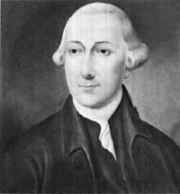 Joseph Hewes
Joseph HewesJoseph Hewes was born at Kingston, New Jersey (now Princeton) on January 23, 1730 at his parents' estate called Maybury Hill. His ancestors had first emigrated to America from England around 1635. His parents were Aaron and Providence Hewes, Quaker farmers who fled to New Jersey in 1728, shortly after they were married, due to religious persecution from New England Puritans and frequent Indian incursions into Connecticut. As they were traveling to New Jersey, an Indian party attacked them and wounded Mrs. Hewes with a gunshot to the neck.
Little is known of Joseph's childhood, but he did pursue a classical education and attended the College of New Jersey (now Princeton). After graduating, Joseph apprenticed as a counting house clerk with a Philadelphia merchant. After his apprenticeship and with some financial help from his father, Joseph set up his own mercantile business and soon became a prosperous merchant, living alternately in Philadelphia and New York.
Joseph Hewes goes to North Carolina
Joseph relocated to Wilmington, North Carolina in 1760 at the age of 30, where he built a prosperous mercantile and shipping business. He moved to Edenton in 1763. His business was located at the corner of Main and King streets in Edenton. Along with his partner Robert Smith, Joseph Hewes built a mercantile empire, amassed a fleet of ships and a large fortune by the time of the Revolutionary War. His first ship was called the Providence, after his mother.
As a young man, Joseph was engaged to be married, but his fiance, Isabella Johnston died a few days before the planned marriage. He never married or had any children after that. Isabella was the sister of Samuel Johnston who was later a governor of North Carolina. Samuel Johnston was also elected the first President of Congress under the Articles of Confederation, but he declined the position.
Hewes earned a solid reputation with his Edenton neighbors and was first elected to the Provincial Assembly State House of Commons in 1766, a position he was continually reelected to until the legislature was dissolved by the Royal Governor in 1775. He was an early advocate of appealing to the British through reasoning, rather than through military rebellion. Nonetheless, he used his influence to encourage North Carolinians to form a State Convention to second Massachusetts' call for a Congress of all the colonies. He began to serve as a member of North Carolina's Committee of Correspondence in 1773. Committees of Correspondence were formed in each colony to inform the other colonies of news that was relevant to the patriots' cause.
Joseph Hewes goes to Congress
When the First North Carolina Provincial Congress met in 1774, Hewes was elected as a delegate, a position he held until 1775. Because of his steadfastness to the American cause, Mr. Hewes was elected by the State Convention to attend the Continental Congress in 1774. He went to Philadelphia where the First Continental Congress began its session in September, taking his seat in Congress on the 14th. Joseph Hewes was 44 at the time. He served in the Continental Congress from 1774-76 and again in 1779.
During his time in Congress, Mr. Hewes served on several important committees including the Committee of Correspondence, to which he advocated that they prepare a document that would "state the rights of the colonies in general, the several instances in which these rights are violated or infringed, and the means most proper to be pursued for obtaining a restoration of them." The result was the Declaration and Resolves of the First Continental Congress. This report became a major production of the First Continental Congress and Mr. Hewes served on the preparation committee. You can read the Declaration and Resolves here.
One of the report's recommendations was that the colonies adopt a strict non-importation, non-consumption, non-exportation agreement that would cut off all trade with Great Britain until the Americans' demands were addressed. Mr. Hewes had a lot to lose by supporting such an agreement, because he had been extensively involved with trade with Britain for many years, but due to his strong sense of patriotism he wholeheartedly supported the agreement.
Joseph Hewes - Father of the United States Navy
In 1775, Mr. Hewes was elected to the new Provincial Assembly of North Carolina and returned to Congress in May 1775. He severed his ties with the Quaker church at this time because of their pacifist leanings and denunciations of Congress. On October 5, 1775, Congress voted to arm four ships for battle, forming a committee of seven people to oversee the new navy. The committee consisted of Hewes of North Carolina, John Adams of Massachusetts, Stephen Hopkins of Rhode Island, Richard Henry Lee of Virginia, Silas Deane of Connecticut, Christopher Gadsden of South Carolina and John Langdon of New Hampshire.
At the beginning of the year 1776 and due to his experience with shipping, Joseph Hewes was appointed the head of the Naval Committee. He gave his fleet over to the use of the Continental Navy and oversaw the disbursement of funds to equip all naval vessels in the service of the Continental Navy. In his role as Secretary of the Navy, which was not a given title at the time, Hewes assisted General George Washington in drawing up his initial plans of operation for the pending war.
Mr. Hewes served as Secretary of the Navy until his death in 1779. He worked tirelessly at his military command, often working 12-14 hour days and frequently without eating, until his health began to decline. Because of this, John Adams said that Joseph Hewes, "laid the foundation, the cornerstone of the American Navy." Mr. Hewes appointed the naval hero John Paul Jones to captain the Navy's first commissioned ship. John Paul Jones was a young Scottish seaman who had recently moved to Virginia that Hewes had befriended and aided as a benefactor.
The captaincies of naval vessels were a matter of contention between Hewes and fellow delegate to Congress, John Adams of Massachusetts. Adams, a New Englander, had yielded to the wishes of the southern colonies by supporting a southerner, George Washington, for the position of Commander in Chief of the Continental Army. In return, he wanted all ships in the Continental Navy to be captained by New Englanders. Joseph Hewes knew he could not win this battle with John Adams and he yielded to Adams' wishes. Consequently, John Paul Jones only received the commission of lieutenant. Nonetheless, he went on to be the most celebrated naval hero of the Revolutionary War. His naval successes during the war are well chronicled and he later often thanked and gave the credit to Joseph Hewes who had helped him so much.
Joseph Hewes & the Declaration of Independence
In April of 1776, the Fourth Provincial Congress of North Carolina, meeting at Halifax, produced what later became known as the Halifax Resolves. Joseph Hewes served on the committee that wrote up this document that declared North Carolina's grievances against England and instructed its delegates to the Continental Congress to vote for independence from Great Britain if the other colonies moved to do so. This was the first official call for independence from Britain from any colony. You can read the Halifax Resolves here.

Hewes himself had mixed feelings about declaring independence from Great Britain. He was given the task of presenting the Halifax Resolves to the Continental Congress and he did so reluctantly. You can read an interesting letter Hewes wrote to his friend James Iredell during this period. George Washington would later appoint Iredell to the first Supreme Court. In the letter, Hewes relates the efforts of Congress to acquire clothes, ammunition and supplies for the army. He also questions Iredell about whether or not the British had attacked North Carolina and if the state had yet adopted a new constitution. You can read the May 17, 1776 letter from Hewes to James Iredell here.
On June 7, Richard Henry Lee of Virginia presented a formal resolution to Congress asking for a vote to declare independence from Great Britain, which Hewes opposed at first. This resolution has become known as the Lee Resolution, after its presenter. You can read the Lee Resolution to declare independence here. As debate continued over the Lee Resolution, Joseph Hewes gradually began to change his mind about independence and, in the words of John Adams, during the debate, "He started suddenly upright and lifting up both his hands to Heaven, as if he had been in a trance, cried out, 'It is done! and I will abide by it.'"
On June 28, Hewes wrote to Iredell again, stating his confidence that:
"On Monday the great question of independence and Total Separation from all political intercourse with Great Britain will come on, it will be carried I expect by a great Majority and then I suppose we shall take upon us a New Name."
You can read the complete June 28, 1776 letter from Hewes to James Iredell here.
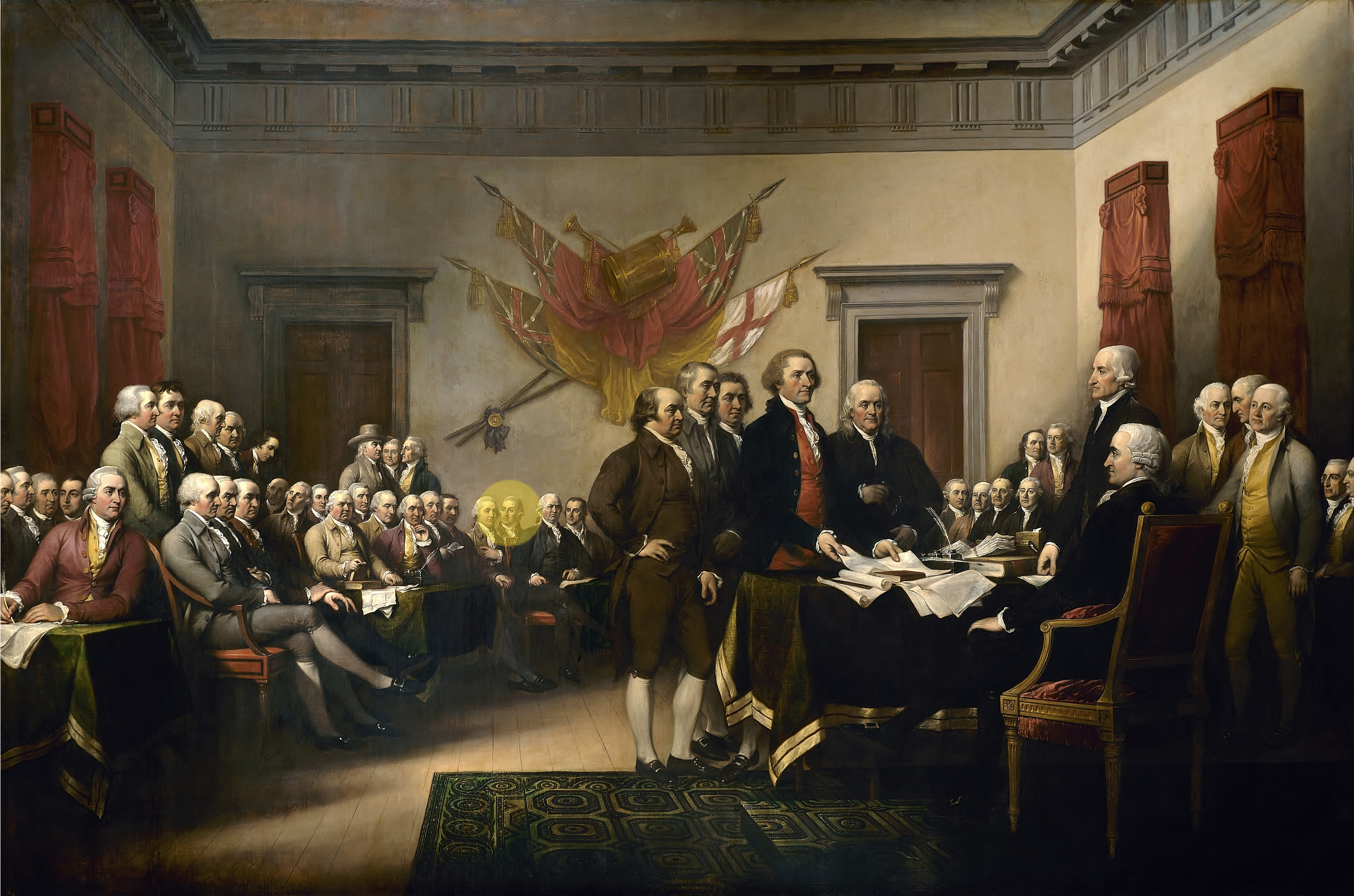
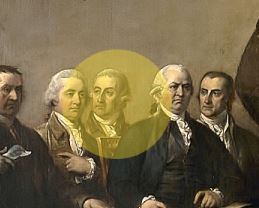
Joseph Hewes went on to vote for independence from Great Britain on July 2 and for Jefferson's formal Declaration of Independence on July 4th, signing the parchment copy with the other delegates on August 2nd. Neither Hewes nor the other two signers from North Carolina were natives of the state. You can read more about the history and purpose of the Declaration of Independence here.
The Lee Resolution also called for a formal confederation of the thirteen colonies. Joseph Hewes served on the committee appointed for the purpose of preparing a formal document joining the states together into a union. The result of their work was the Articles of Confederation.
Hewes was reelected to Congress in 1776, but didn't serve due to his illness, though he did continue to serve as Secretary of War. Instead, he remained at home to attend to his personal affairs which were suffering from neglect due to his absence while serving in Congress. In 1777, the North Carolina Assembly tried to employ Mr. Hewes to outfit two more ships to use against Great Britain, but he declined because of his duties in overseeing the Continental Navy. Mr. Hewes was elected to the North Carolina House of Commons in 1778 and 1779 and was reelected to Congress in 1779.
Joseph Hewes -
One of the first signers of the
Declaration of Independence to die
 Joseph Hewes grave marker Christ Church burial ground Philadelphia
Joseph Hewes grave marker Christ Church burial ground PhiladelphiaJoseph Hewes began the term of Congress in September 1779, but his health was quickly deteriorating. The last day he appeared in Congress was October 29, after which he collapsed and never fully recovered. Mr. Hewes was too ill to return to North Carolina, so he remained in Philadelphia. He remained confined to his bed until he finally passed away on November 10 at the age of 49, a few months before his 50th birthday. Many people believe that he worked himself to death in the cause of his country. Joseph Hewes was the second signer of the Declaration of Independence to die, Button Gwinnett was the first, and the only one to die at Philadelphia while serving in office.
Mr. Hewes is a celebrated war hero and played an important part in America's victory over Great Britain, as well as North Carolina's strong zeal for independence and its early adoption of the cause. Mr. Hewes' funeral was held at Christ Church in Philadelphia on November 11, 1779, and was attended by George Washington and the entire Congress, as well as the General Assembly of Pennsylvania, the president and supreme executive council of Pennsylvania and the minister plenipotentiary of France. Congress voted to wear a black crepe around the left arm as a sign of mourning for the next month. Mr. Hewes was truly a revolutionary war hero who sacrificed everything, including his own life, for the cause of American independence. Mr. Hewes died lonely, never having married, stating in his diary that he never intended to remain a bachelor. He had no children to whom he could leave his large inheritance.
A marker is erected in the graveyard at Christ Church commemorating the life of Joseph Hewes, but the exact location of his grave is unknown. The marker was erected in 1963 by the National Society of the Daughters of the American Revolution of North Carolina. The inscription on the marker reads:
Born: January 23, 1730
Died: November 10, 1779
Delegate to all five provincial congresses
Member Continental Congress 1774-1777-1779
Signer of Declaration of Independence
from North Carolina
First Executive head of the Navy
"One of the best and most agreeable men in the world"
Buried in Christ Church burial ground,
Philadelphia.
Erected by National Society Daughters
of American Revolution
of North Carolina, April 1963
Other notable people such as Benjamin Franklin, Francis Hopkinson, Dr. Benjamin Rush and George Ross, all signers of the Declaration of Independence, are buried at Christ Church as well. You can learn more about the Christ Church Burial Grounds here.
In 1894, a monument to the three North Carolina signers of the Declaration of Independence was erected on the grounds of the Guilford Courthouse National Military Park, the scene of the Battle of Guilford Courthouse. The bodies of John Penn and William Hooper were reinterred here at that time, but since the location of his grave was unknown, obviously Joseph Hewes could not be reinterred here with the others. The statue on top of the monument represents William Hooper, whom John Adams called one of the great "Orators of Congress." The inscription on the monument reads like this:
"In Memoriam William Hooper and John Penn Delegates from North Carolina, 1776 to the Continental Congress and signers of the Declaration of Independence. Their remains were re-interred here 1894. Hewes grave is lost. He was the third signer."
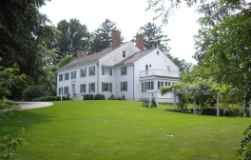 Maybury Hill
Maybury HillThe home of Joseph Hewes' birth, known as Maybury Hill, still stands today. The original structure burned in 1735 when Hewes was five years old, but it was rebuilt. Additions were added in 1753 and 1993. Maybury Hill was designated a National Historic Landmark in 1971. It can be found at 346 Snowden Lane, Princeton, New Jersey in Mercer County. It is privately owned.
Two United States naval vessels were named after Joseph Hewes. The first was a passenger liner called Excalibur, which was built in 1930 and requisitioned by the army on January 8, 1942. It was renamed USS Joseph Hewes (AP-50). It was sunk by the Germans off the coast of North Africa on November 11, 1942, taking down her Captain, Robert C. Smith and 100 sailors and soldiers with her. For more information about this ship, please click here.
 USS Joseph Hewes Destroyer
USS Joseph Hewes DestroyerThe Knox Class Destroyer USS Joseph Hewes was also named after Joseph Hewes and was commissioned in 1971. It served the United States for more than 20 years in such places as Vietnam, Beirut and the Mediterranean. The ship was decommissioned in 1994 and sold to the Taiwanese Navy, which renamed her the Lan Yang. The Lan Yang is still in service today. You can learn more about the USS Joseph Hewes at this website.
You can play the Joseph Hewes online crossword puzzle here. All of the answers in the puzzle can be found in the biography above.
Other North Carolina signers of the Declaration of Independence:
Return to Founding Fathers Page
Revolutionary War and Beyond Home
Like This Page?
© 2008 - 2022 Revolutionary-War-and-Beyond.com Dan & Jax Bubis

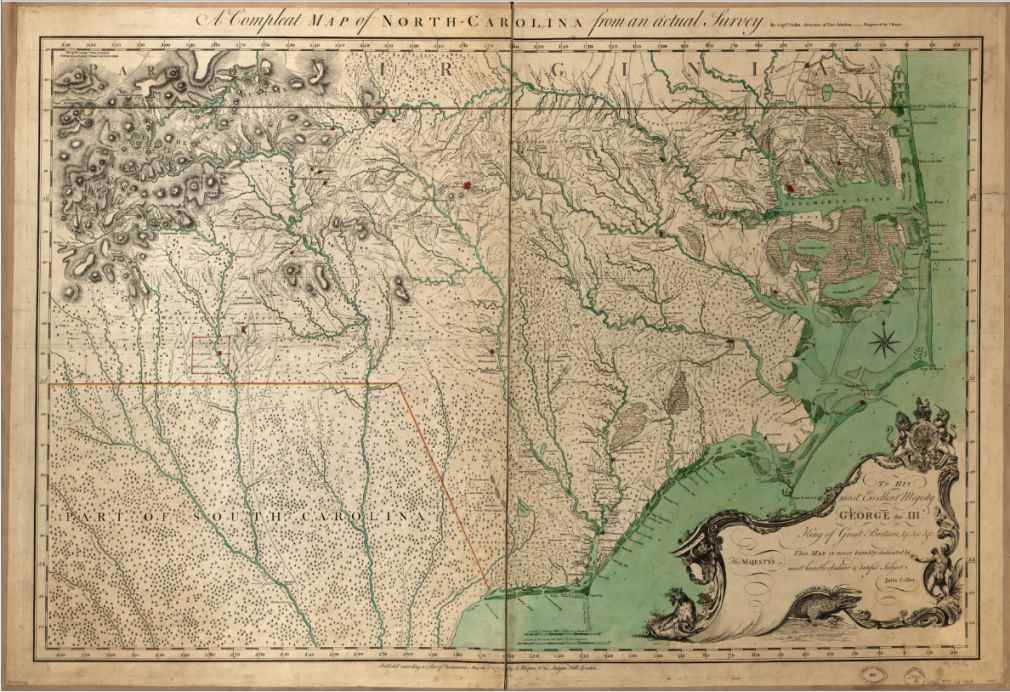

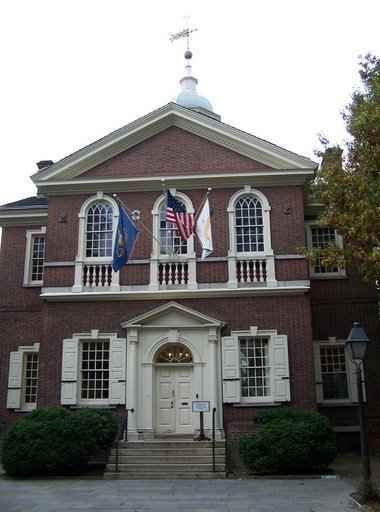
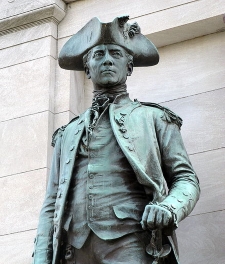
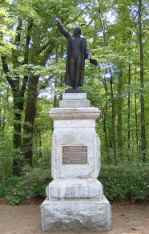









Facebook Comments